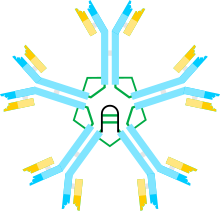Isolated primary immunoglobulin M deficiency
Isolated primary immunoglobulin M deficiency[1] is a poorly defined dysgammaglobulinemia characterized by decreased levels of IgM while levels of other immunoglobulins are normal. The immunodeficiency has been associated with some clinical disorders including recurrent infections, atopy, Bloom's syndrome, celiac disease, systemic lupus erythematosus and malignancy, but, surprisingly, SIgMD seems to also occur in asymptomatic individuals.[2] High incidences of recurrent upper respiratory tract infections (77%), asthma (47%) and allergic rhinitis (36%) have also been reported.[3] SIgMD seems to be a particularly rare antibody deficiency with a reported prevalence between 0.03% (general population) and 0.1% (hospitalized patients).[2]
| Isolated primary immunoglobulin M deficiency | |
|---|---|
| Other names | Selective IgM immunodeficiency |
 | |
| Immunoglobulin M | |
| Specialty | Hematology |
The cause of selective IgM deficiency remains unclear, although various mechanisms have been proposed, such as an increase in regulatory T cell functions, defective T helper cell functions and impaired terminal differentiation of B lymphocytes into IgM-secreting cells among others.[2] In addition it was recently described that hypomorphic mutations in the B-cell receptor (BLNK & BTK) lead to selective IgM deficiency.[4]
It is however puzzling that class switching seems to happen normally (serum levels of other antibodies are normal), while dysfunctioning of IgM synthesis is expected to occur together with abnormalities in other immunoglobulins. Notwithstanding a clear pathogenesis and commonly accepted definition, a cutoff for SIgMD could be the lower limit of the serum IgM reference range, such as 43 mg/dL[5] in adults or even 20 mg/dL.[6]
Signs and symptoms
editPatients diagnosed with isolated primary immunoglobulin M deficiency frequently exhibit recurrent infections with common microorganisms as well as a higher incidence of autoimmune and allergy disorders. More than 80% of patients with isolated primary immunoglobulin M deficiency have recurrent infections as their presenting symptom. Serious, potentially fatal illnesses could arise from several of these bacterial diseases. Isolated primary immunoglobulin M deficiency can manifest clinically as recurrent otitis media, bronchiectasis, chronic sinusitis, bronchitis, urinary tract infections, respiratory infections, cellulitis, meningitis, and sepsis.[7]
See also
editReferences
edit- ^ Rapini, Ronald P.; Bolognia, Jean L.; Jorizzo, Joseph L. (2007). Dermatology: 2-Volume Set. St. Louis: Mosby. ISBN 978-1-4160-2999-1.
- ^ a b c Yel L, Ramanuja S, Gupta S (2009). "Clinical and Immunological Features in IgM Deficiency". Int Arch Allergy Immunol. 150 (3): 291–8. doi:10.1159/000222682. PMID 19494527. S2CID 23098220.
- ^ Goldstein MF, Goldstein AL, Dunsky EH, Dvorin DJ, Belecanech GA, Shamir K (2006). "Selective IgM immunodeficiency: retrospective analysis of 36 adult patients with review of the literature". Ann Allergy Asthma Immunol. 97 (6): 717–30. doi:10.1016/S1081-1206(10)60962-3. PMID 17201230.
- ^ Geier, Christoph (18 December 2018). "Hypomorphic Mutations in the BCR Signalosome Lead to Selective Immunoglobulin M Deficiency and Impaired B-cell Homeostasis". Frontiers in Immunology. 9: 2984. doi:10.3389/fimmu.2018.02984. PMC 6305442. PMID 30619340.
- ^ UC Davis Medical Center. "Revised reference range IgM" (PDF). Retrieved 30 December 2011.
- ^ The Merck Manual of Diagnosis and Therapy. Merck Sharp & Dohme Corp. 2004. pp. Appendix II.
- ^ Gupta, Sudhir; Gupta, Ankmalika (2017-09-05). "Selective IgM Deficiency—An Underestimated Primary Immunodeficiency". Frontiers in Immunology. 8. Frontiers Media SA. doi:10.3389/fimmu.2017.01056. ISSN 1664-3224. PMC 5591887.